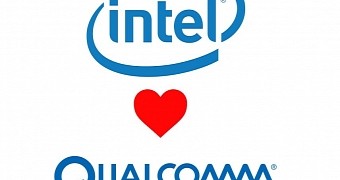Qualcomm has just announced that major structural reforms will be taking place inside the company, in the hopes of reducing spending by approximately $1.4 billion (€1.27 billion).
The process is expected to last until the end of fiscal year 2016. With this intent in mind, the company will be forced to lay off about 4,500 employees, meaning 15% of its entire workforce, which is currently made up of 31,000 full-time and temporary employees.
The US-based chip maker has also said that it is considering splitting into separate businesses in the hopes of doing damage control. And now, analysts on Wall Street are saying that none other than Intel should buy Qualcomm, if the latter decides to break up its business, reports Reuters.
Timothy Arcuri, analyst for Cown and Co, called this potential merging of the two “the chip deal to end all chips deals.”
Intel and Qualcomm could help each other
The merger might give Intel’s smartphone business a chance to rise and shine, by boosting sluggish handset sales and expanding into lofty markets like India and China. On the other side of the fence, Intel could take up the manufacturing of Qualcomm processors thanks to its in-house chip foundries.
Qualcomm’s current chip business is estimated to be worth between $30 and $40 million (€27 - 36 million). Other suitors for Qualcomm include a consortium backed by the Chinese government and Samsung Electronics.
The US chip giant has been going through a rough patch as of late. The company lost the Samsung Galaxy S6 contract because the Korean tech giant decided it should use its in-house chips exclusively. Then came the Snapdragon 810 fiasco and the fact that device manufacturers started sourcing their chips from competitors, such as low-cost silicon maker MediaTek.
For example, companies that were once faithful exclusively to Qualcomm, like HTC and Sony, have showed willingness to diversify their portfolio by including handset models with MediaTek processors embedded on the inside.
The reason for that is that the competition has upgraded its standard too and is now shipping silicon platforms with modems, Wi-Fi, and Bluetooth components.
But there are concerns related to the splitting scenario. If Qualcomm ends up dividing its chip side from its licensing side, the overall impact might not be a favorable one. At the moment, Qualcomm uses license fees revenue to fund research and development for its chip designs. So there’s a high risk that a newly formed manufacturing side might underfund processor evolution.

 14 DAY TRIAL //
14 DAY TRIAL //